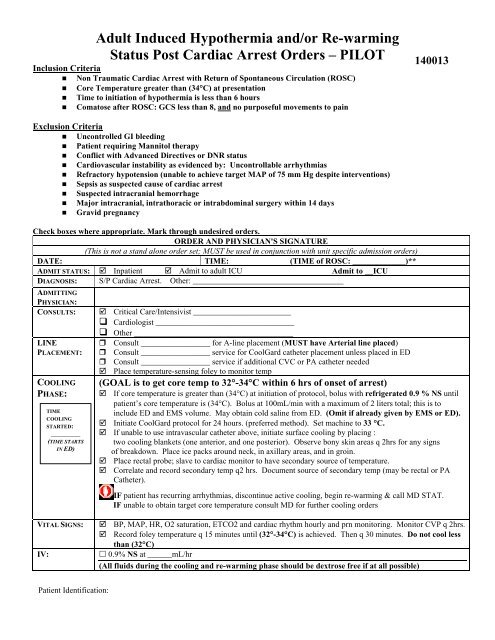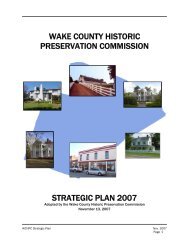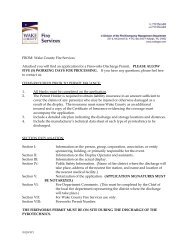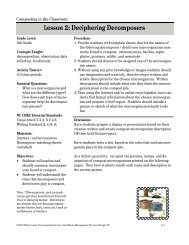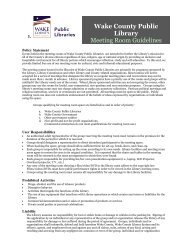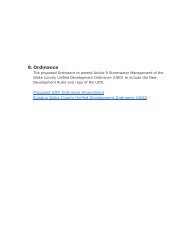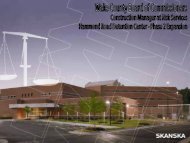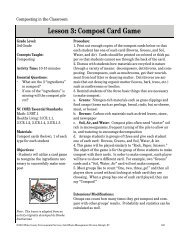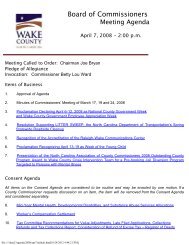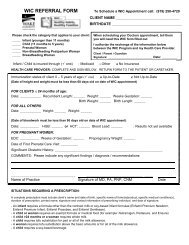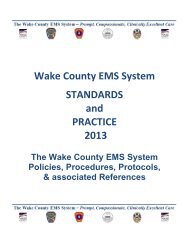Wake Hospital Hypothermia Protocol
Wake Hospital Hypothermia Protocol
Wake Hospital Hypothermia Protocol
You also want an ePaper? Increase the reach of your titles
YUMPU automatically turns print PDFs into web optimized ePapers that Google loves.
Adult Induced <strong>Hypothermia</strong> and/or Re-warming<br />
Status Post Cardiac Arrest Orders – PILOT<br />
140013<br />
Inclusion Criteria<br />
• Non Traumatic Cardiac Arrest with Return of Spontaneous Circulation (ROSC)<br />
• Core Temperature greater than (34°C) at presentation<br />
• Time to initiation of hypothermia is less than 6 hours<br />
• Comatose after ROSC: GCS less than 8, and no purposeful movements to pain<br />
Exclusion Criteria<br />
• Uncontrolled GI bleeding<br />
• Patient requiring Mannitol therapy<br />
• Conflict with Advanced Directives or DNR status<br />
• Cardiovascular instability as evidenced by: Uncontrollable arrhythmias<br />
• Refractory hypotension (unable to achieve target MAP of 75 mm Hg despite interventions)<br />
• Sepsis as suspected cause of cardiac arrest<br />
• Suspected intracranial hemorrhage<br />
• Major intracranial, intrathoracic or intrabdominal surgery within 14 days<br />
• Gravid pregnancy<br />
Check boxes where appropriate. Mark through undesired orders.<br />
ORDER AND PHYSICIAN'S SIGNATURE<br />
(This is not a stand alone order set; MUST be used in conjunction with unit specific admission orders)<br />
DATE: TIME: (TIME of ROSC: _____________)**<br />
ADMIT STATUS: Inpatient Admit to adult ICU Admit to __ICU<br />
DIAGNOSIS: S/P Cardiac Arrest. Other: _____________________________________<br />
ADMITTING<br />
PHYSICIAN:<br />
CONSULTS:<br />
LINE<br />
PLACEMENT:<br />
COOLING<br />
PHASE:<br />
TIME<br />
COOLING<br />
STARTED:<br />
_________<br />
(TIME STARTS<br />
IN ED)<br />
Critical Care/Intensivist ________________________<br />
Cardiologist __________________________________<br />
Other _______________________________________<br />
Consult _________________ for A-line placement (MUST have Arterial line placed)<br />
Consult _________________ service for CoolGard catheter placement unless placed in ED<br />
Consult _________________ service if additional CVC or PA catheter needed<br />
Place temperature-sensing foley to monitor temp<br />
(GOAL is to get core temp to 32°-34°C within 6 hrs of onset of arrest)<br />
If core temperature is greater than (34°C) at initiation of protocol, bolus with refrigerated 0.9 % NS until<br />
patient’s core temperature is (34°C). Bolus at 100mL/min with a maximum of 2 liters total; this is to<br />
include ED and EMS volume. May obtain cold saline from ED. (Omit if already given by EMS or ED).<br />
Initiate CoolGard protocol for 24 hours. (preferred method). Set machine to 33 °C.<br />
If unable to use intravascular catheter above, initiate surface cooling by placing :<br />
two cooling blankets (one anterior, and one posterior). Observe bony skin areas q 2hrs for any signs<br />
of breakdown. Place ice packs around neck, in axillary areas, and in groin.<br />
Place rectal probe; slave to cardiac monitor to have secondary source of temperature.<br />
Correlate and record secondary temp q2 hrs. Document source of secondary temp (may be rectal or PA<br />
Catheter).<br />
IF patient has recurring arrhythmias, discontinue active cooling, begin re-warming & call MD STAT.<br />
IF unable to obtain target core temperature consult MD for further cooling orders<br />
VITAL SIGNS:<br />
IV:<br />
BP, MAP, HR, O2 saturation, ETCO2 and cardiac rhythm hourly and prn monitoring. Monitor CVP q 2hrs.<br />
Record foley temperature q 15 minutes until (32°-34°C) is achieved. Then q 30 minutes. Do not cool less<br />
than (32°C)<br />
0.9% NS at ______mL/hr<br />
(All fluids during the cooling and re-warming phase should be dextrose free if at all possible)<br />
Patient Identification:<br />
Origin:R10/06<br />
Page: 1 of 4<br />
<strong>Wake</strong>Med<br />
Physician’s Orders<br />
Critical Care Folder
BP & VOLUME<br />
MANAGEMENT:<br />
ANALGESIA<br />
SEDATION<br />
Adult Induced <strong>Hypothermia</strong> and/or Re-warming<br />
Status Post Cardiac Arrest Orders – PILOT<br />
*(Goal MAP to be at least 75 mm Hg)<br />
Replace urine output q 1 hr with: NS ½ NS LR using:<br />
0.5 mL/ 1 ml IVF replacement to urine output<br />
1 mL/ 1 ml IVF replacement to urine output<br />
Observe closely for fluid overload. Consider using Pressors next if urine output is > 0.5 ml/kg/hr<br />
CVP goal of 6-10 mmHg or _______<br />
Additional IV volume support: ___________________________<br />
Norepinephrine (Levophed) IV start at 0.5 mcg/min and titrate as needed to keep MAP greater than 75.<br />
Other pressor agent: _______________________________________________________<br />
Nitroglycerin IV start if MAP over 120 or _____. Start at 5 mcg/min, increase by 5 mcg/min increments q<br />
3-5 min until a BP response is noted. Goal is to keep MAP* less than 120 OR ___________________<br />
Other: ___________________________________________________________________<br />
Use numeric rating scale (1-10) or other pain scale to assess for pain/discomfort prior to administering a<br />
NeuroMuscular Blocking Agent (NMBA.)<br />
Goal for analgesia: less than or equal to 3, on 1-10 scale, or minimal pain behaviors.<br />
Other: ______________________<br />
(Numeric rating scale will not be applicable for assessing patients receiving a NMBA.)<br />
Fentanyl _____ mcg/hr (2 mcg/kg/hr initially) continuous infusion. (Pharmacy to mix in NS).<br />
(Consider if patient is hemodynamically unstable or has renal insufficiency, or if Creatinine Clearance < 50 mL/min.)<br />
OR:<br />
Morphine _____ mg/hr (0.1 mg/kg/hr) continuous infusion<br />
(Consider if patient is hemodynamically stable.)<br />
Use Riker scale of 1-7 to assess sedation prior to administering an NMBA.<br />
Goal for sedation: 2-3 on Riker Scale of 1-7<br />
Other: ___________<br />
(Riker scale will not be applicable for assessing patients receiving an NMBA. May consider use of BIS<br />
monitoring for level of sedation, however, BIS monitor may not stick due to cold skin, so titrate therapy to<br />
prevent shivering.)<br />
NEUROMUSC-<br />
ULAR<br />
BLOCKING<br />
AGENT<br />
(NMBA)<br />
(For prevention<br />
of shivering)<br />
DVT<br />
PROPHYLAXIS<br />
STRESS<br />
ULCER<br />
PROPHYLAXIS<br />
Lorazepam (Ativan): ______ mg/hr (0.01 mg/kg/hr initially) continuous infusion, titrate until at goal.<br />
OR:<br />
Propofol (Diprivan): ______ mcg/min (5 mcg/kg/min initially) continuous infusion, titrate Q 5 minutes until<br />
at goal. Monitor triglycerides after 48 hours. Dosing not to exceed 80 mcg/kg/min. Vial and tubing must be changed Q 12 Hours. Need<br />
to discontinue propofol after 3 days; consult with MD for further sedation requirements.<br />
Before starting neuromuscular blocking agent (NMBA), verify that the patient is adequately medicated<br />
with analgesic and sedative agents at goal and receiving mechanical ventilation.<br />
Obtain baseline “train of four” (TOF) then Q 1 Hour. Adjust degree of NMBA to achieve 1-2 of 4. If unable to obtain TOF,<br />
titrate NMBA to prevent shivering.<br />
Vecuronium (Norcuron): ______ mg (0.1 mg/kg) IV bolus x 1 (unless NMBA bolus given by ED or EMS)<br />
Vecuronium (Norcuron): _______ mcg/min (0.8-1.2 mcg/kg/min) continuous infusion. Pharmacy to mix 1:1 in NS<br />
(Avoid in significant renal or hepatic impairment..)<br />
If significant renal or hepatic dysfunction, consider:<br />
Cisatracurium (Nimbex): _______ mg (0.2 mg/kg) IV bolus x 1(unless NMBA bolus given by ED or EMS)<br />
Cisatracurium (Nimbex): _______ mcg/min (2.5-3 mcg/kg/min) continuous infusion<br />
Sequential compression devices (SCDs). Use Foot Pumps if unable to use SCDs<br />
Heparin 5000 units subcutaneously Q 8 Hours<br />
OR<br />
Dalteparin (Fragmin) 5000 units subcutaneously daily<br />
Other: _______________________________<br />
Famotidine (Pepcid) 20 mg PO/NG tube/IV Q 12 Hours stress ulcer prophylaxis<br />
If Creatinine Clearance < 50 mL/min, give famotidine (Pepcid) 20 mg PO/NG tube/IV Q 24 Hours<br />
Other: ______________________________<br />
Patient Identification:<br />
Origin:R10/06<br />
Page: 2 of 4<br />
<strong>Wake</strong>Med<br />
Physician’s Orders<br />
Critical Care Folder
OTHER<br />
MEDICATIONS<br />
NURSING:<br />
VENT<br />
MANAGEMENT:<br />
IF NOT DONE IN<br />
ED: STAT<br />
LABS:<br />
STAT<br />
DIAGNOSTICS<br />
LABS EVERY 6<br />
HOURS X 24HRS<br />
12 HOURS<br />
AFTER<br />
INITIATION OF<br />
PROTOCOL<br />
DAILY<br />
OTHER LABS OR<br />
DIAGNOSTICS<br />
ELECTROLYTE<br />
REPLACEMENT<br />
Adult Induced <strong>Hypothermia</strong> and/or Re-warming<br />
Status Post Cardiac Arrest Orders – PILOT<br />
Lacrilube to both eyes Q 4 Hours and PRN while on NMBA.<br />
Initiate unit-specific (Glucomander or Adult Intensive Insulin <strong>Protocol</strong>) hyperglycemic management<br />
order set (Goal BG 80-110 mg/dL). Do NOT use fingersticks.<br />
For intubated/trached patients: Chlorhexidine gluconate 0.12% (Peridex) 15 mL Q 12 Hours. Swab all oral<br />
surfaces (buccal, pharyngeal, gingival, tongue and tooth surfaces) for 30 seconds. Discontinue when patient<br />
extubated. If trached, continue for 6 months and then reevaluate. Note: Solution not to be swallowed.<br />
Acetaminophen (Tylenol)* 650mg per feeding / NG tube / PR q 4hr PRN hyperthermia (which is temp above<br />
98.6°F/ 37°C) during re-warming phase. If given via tube, clamp x 30 min. *Dosage not to exceed<br />
4gm/24hrs. Consider all sources.*<br />
Caution: Do not administer any medication to hypothermic patient if medication is labeled “Do not<br />
refrigerate”. (Example: Mannitol)<br />
Insert NG/OG to low intermittent wall suction<br />
Intake and output hourly; Call MD if urine output is less than 0.5 mL/kg/hr despite above volume given<br />
Monitor CVP and A-line; use saline flush only for pressure line<br />
If femoral line, place in reverse Trendelenberg to raise HOB as much as possible without kinking line<br />
Do NOT bathe patient during hypothermic or rewarming period<br />
Vent Settings: _____________________________________________________________<br />
Calculate Ideal Body Weight on admission; to be used for ventilator management only: ________<br />
No warm humidified air<br />
Continuous ETCO 2 monitoring<br />
ABG prn monitor oxygenation and/or acid/base status (make sure temperature corrected) (Goal PaCO 2 35-45)<br />
BMP CBC Phos ABG (temp corrected)<br />
Calcium PT<br />
Magnesium Troponin<br />
UA PTT Lactate Urine HCG<br />
Other:<br />
PCXR 12 lead ECG Other: ___________________________<br />
BMP<br />
PT<br />
PTT<br />
Calcium<br />
CBC with diff<br />
Magnesium<br />
Phos<br />
Other: ___________________________________<br />
Blood Culture x 2 at ________<br />
Other: _______________________________________________________<br />
PCXR and ABG while on ventilator<br />
CBC and BMP every am<br />
Other:<br />
Troponin<br />
CK’s q ___ hrs x ___<br />
Other:<br />
**Do not replace potassium unless it is less than 3 meq/L during cooling phase. Call MD for specific<br />
replacement dose. Make sure time to rewarm phase is communicated.<br />
D O NOT USE PRE- EXISTING ELECTROLYTE REPLACEMENT ORDERS<br />
Patient Identification:<br />
Origin:R10/06<br />
Page: 3 of 4<br />
<strong>Wake</strong>Med<br />
Physician’s Orders<br />
Critical Care Folder
Adult Induced <strong>Hypothermia</strong> and/or Re-warming<br />
Status Post Cardiac Arrest Orders – PILOT<br />
*************<br />
RE-WARMING<br />
PHASE:<br />
A. TIME<br />
RE-WARMING<br />
STARTED:<br />
___________<br />
B. TIME<br />
COOLING<br />
STARTED IN<br />
ED:<br />
___________<br />
C. TIME<br />
RE-WARMING<br />
FINISHED:<br />
________<br />
**************************************************************************************<br />
*<br />
Target temperature (36.1°- 37°C)<br />
Begin rewarming 24hrs from time cooling was started in Emergency Department.<br />
Target temperature to be obtained in 6-8hrs; STOP re-warming once (36.1°C) is reached to<br />
prevent overshoot.<br />
Empty foley at start of rewarming. Strict I & O (see volume replacement section)<br />
Activate re-warming (program CoolGard for 0.5°C/hr and 36.1°C).<br />
If external cooling devices used, remove cool packs and cooling blankets.<br />
May place warm blankets (do NOT use Bair Hugger)<br />
Monitor temp/VS/rhythm closely q 30 minutes until target temp is reached, then q 1hr x 12 additional<br />
hours, followed by temp/VS q 4hrs IF patient remains normothermic or more if condition warrants<br />
Continue sedation and neuromuscular blocking agent (NMBA) until temperature is equal to or greater<br />
than (36.1°C). (Discontinue NMBA first, then wean sedation.)<br />
Do not permit Hyperthermia in first 24hrs after cooling phase.<br />
IF temp greater than (37°C) administer Acetaminophen<br />
Continue labs as ordered (anticipate increase in potassium)<br />
Continue monitoring I & O q 1hr (anticipate hypovolemia)<br />
Once normothermic goal reached at end of 48 hrs, consult with MD service for D/C of femoral line<br />
SHIVERING : Observe for shivering q 1 hour<br />
If off neuromuscular blockade, and shivering occurs during rewarming phase apply warm blankets.<br />
Meperidine (Demerol) 12.5mg IV, may repeat in 5 minutes x 1<br />
IF above methods(s) ineffective, call MD STAT for further orders (may need to restart NMBA<br />
and sedation)<br />
Physician signature required: Transcribed by:<br />
Checked by (Nurse):<br />
_____________________________ _________________________ ______________________________<br />
Beeper #: _______------_____________ Date:___________ Time: Date: ____________ Time: ____________<br />
_______<br />
Patient Identification:<br />
Origin:R10/06<br />
Page: 4 of 4<br />
<strong>Wake</strong>Med<br />
Physician’s Orders<br />
Critical Care Folder


